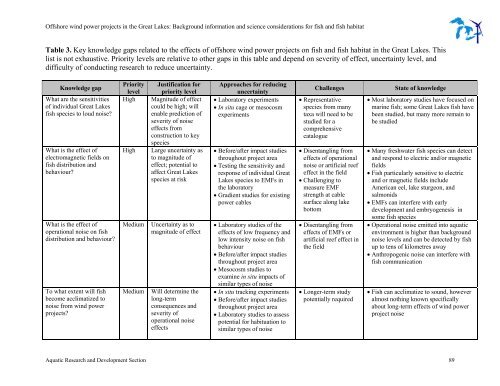Offshore Wind Power Projects in the Great Lakes - Ministry of ...
Offshore Wind Power Projects in the Great Lakes - Ministry of ...
Offshore Wind Power Projects in the Great Lakes - Ministry of ...
You also want an ePaper? Increase the reach of your titles
YUMPU automatically turns print PDFs into web optimized ePapers that Google loves.
<strong>Offshore</strong> w<strong>in</strong>d power projects <strong>in</strong> <strong>the</strong> <strong>Great</strong> <strong>Lakes</strong>: Background <strong>in</strong>formation and science considerations for fish and fish habitat<br />
Table 3. Key knowledge gaps related to <strong>the</strong> effects <strong>of</strong> <strong>of</strong>fshore w<strong>in</strong>d power projects on fish and fish habitat <strong>in</strong> <strong>the</strong> <strong>Great</strong> <strong>Lakes</strong>. This<br />
list is not exhaustive. Priority levels are relative to o<strong>the</strong>r gaps <strong>in</strong> this table and depend on severity <strong>of</strong> effect, uncerta<strong>in</strong>ty level, and<br />
difficulty <strong>of</strong> conduct<strong>in</strong>g research to reduce uncerta<strong>in</strong>ty.<br />
Knowledge gap<br />
What are <strong>the</strong> sensitivities<br />
<strong>of</strong> <strong>in</strong>dividual <strong>Great</strong> <strong>Lakes</strong><br />
fish species to loud noise?<br />
What is <strong>the</strong> effect <strong>of</strong><br />
electromagnetic fields on<br />
fish distribution and<br />
behaviour?<br />
What is <strong>the</strong> effect <strong>of</strong><br />
operational noise on fish<br />
distribution and behaviour?<br />
To what extent will fish<br />
become acclimatized to<br />
noise from w<strong>in</strong>d power<br />
projects?<br />
Priority Justification for<br />
level priority level<br />
High Magnitude <strong>of</strong> effect<br />
could be high; will<br />
enable prediction <strong>of</strong><br />
severity <strong>of</strong> noise<br />
effects from<br />
construction to key<br />
species<br />
High Large uncerta<strong>in</strong>ty as<br />
to magnitude <strong>of</strong><br />
effect; potential to<br />
affect <strong>Great</strong> <strong>Lakes</strong><br />
species at risk<br />
Medium Uncerta<strong>in</strong>ty as to<br />
magnitude <strong>of</strong> effect<br />
Medium Will determ<strong>in</strong>e <strong>the</strong><br />
long-term<br />
consequences and<br />
severity <strong>of</strong><br />
operational noise<br />
effects<br />
Approaches for reduc<strong>in</strong>g<br />
uncerta<strong>in</strong>ty<br />
• Laboratory experiments<br />
• In situ cage or mesocosm<br />
experiments<br />
• Before/after impact studies<br />
throughout project area<br />
• Test<strong>in</strong>g <strong>the</strong> sensitivity and<br />
response <strong>of</strong> <strong>in</strong>dividual <strong>Great</strong><br />
<strong>Lakes</strong> species to EMFs <strong>in</strong><br />
<strong>the</strong> laboratory<br />
• Gradient studies for exist<strong>in</strong>g<br />
power cables<br />
• Laboratory studies <strong>of</strong> <strong>the</strong><br />
effects <strong>of</strong> low frequency and<br />
low <strong>in</strong>tensity noise on fish<br />
behaviour<br />
• Before/after impact studies<br />
throughout project area<br />
• Mesocosm studies to<br />
exam<strong>in</strong>e <strong>in</strong> situ impacts <strong>of</strong><br />
similar types <strong>of</strong> noise<br />
• In situ track<strong>in</strong>g experiments<br />
• Before/after impact studies<br />
throughout project area<br />
• Laboratory studies to assess<br />
potential for habituation to<br />
similar types <strong>of</strong> noise<br />
Challenges State <strong>of</strong> knowledge<br />
• Representative<br />
species from many<br />
taxa will need to be<br />
studied for a<br />
comprehensive<br />
catalogue<br />
• Disentangl<strong>in</strong>g from<br />
effects <strong>of</strong> operational<br />
noise or artificial reef<br />
effect <strong>in</strong> <strong>the</strong> field<br />
• Challeng<strong>in</strong>g to<br />
measure EMF<br />
strength at cable<br />
surface along lake<br />
bottom<br />
• Disentangl<strong>in</strong>g from<br />
effects <strong>of</strong> EMFs or<br />
artificial reef effect <strong>in</strong><br />
<strong>the</strong> field<br />
• Longer-term study<br />
potentially required<br />
• Most laboratory studies have focused on<br />
mar<strong>in</strong>e fish; some <strong>Great</strong> <strong>Lakes</strong> fish have<br />
been studied, but many more rema<strong>in</strong> to<br />
be studied<br />
• Many freshwater fish species can detect<br />
and respond to electric and/or magnetic<br />
fields<br />
• Fish particularly sensitive to electric<br />
and or magnetic fields <strong>in</strong>clude<br />
American eel, lake sturgeon, and<br />
salmonids<br />
• EMFs can <strong>in</strong>terfere with early<br />
development and embryogenesis <strong>in</strong><br />
some fish species<br />
• Operational noise emitted <strong>in</strong>to aquatic<br />
environment is higher than background<br />
noise levels and can be detected by fish<br />
up to tens <strong>of</strong> kilometres away<br />
• Anthropogenic noise can <strong>in</strong>terfere with<br />
fish communication<br />
• Fish can acclimatize to sound, however<br />
almost noth<strong>in</strong>g known specifically<br />
about long-term effects <strong>of</strong> w<strong>in</strong>d power<br />
project noise<br />
Aquatic Research and Development Section 89
















